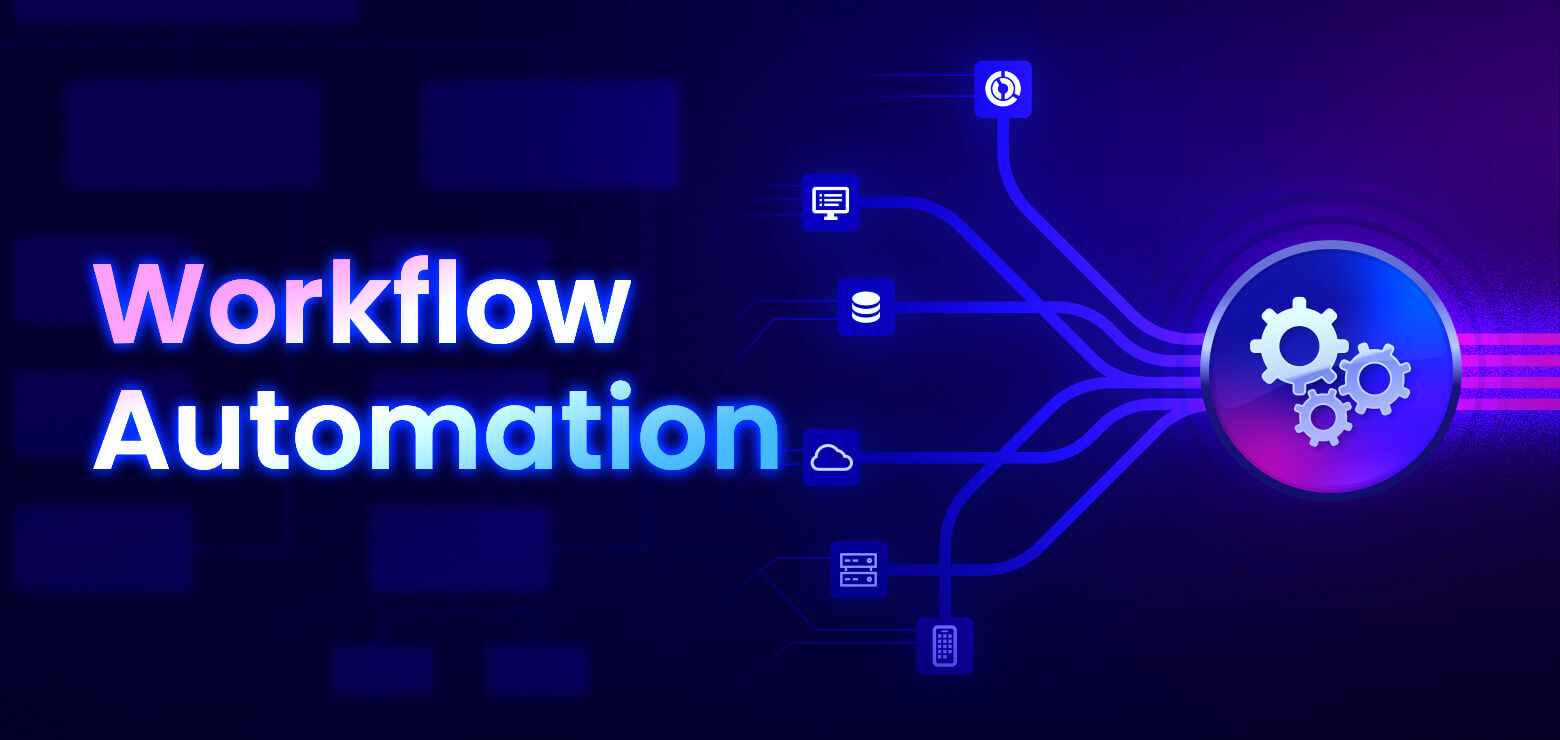Organizations still rely on manual and repetitive tasks that are error-prone and hinder productivity. In addition to this, the IT environments of today are complex, with legacy on-prem systems and new-age SaaS solutions that need to work together seamlessly for businesses to function at an optimal level. Workflow automation is a crucial initiative that will help not just increase efficiency but also aid business growth.
What is workflow automation?
Workflow automation might sound a bit complicated. In many cases, it can be complicated to implement. Don’t fret. The basic idea is simple. Workflow automation is the design, implementation, and automation of common processes using pre-defined rules so that tasks, files, and data are shared between systems and people.
Throughout your organization, there are lots of tasks, documents, and information that need to connect in order to keep the business running. You could have people do that work, or you could automate it with technology. That’s workflow automation: the process of automating all those tasks, documents, and data to eliminate tedious manual labor.
Long story short, workflow automation means less work, fewer inaccuracies, and more time to focus on what’s important.
What are the basics of workflow automation?
To keep things happening the way they’re supposed to, you have to set up a series of rules and logical statements. These if-then statements instruct the programs what actions to take, how and where to move information, and the proper series of tasks to accomplish from start to finish.
Workflow automation can take one of two forms: dynamic or static.
-
Dynamic Workflow
A dynamic workflow changes depending on the context, determining which step is the best one to take. For instance, a dynamic workflow might allow your team to follow-up on leads by sifting through customer questions on your website before adding relevant information to your CRM system and sending the lead to your sales team.
-
Static Workflow
In contrast, a static workflow never changes its steps, even if there are other contextual differences around it. Invoice generation is a great example of static workflows as it simply allows your accounts receivable team to automatically create and send invoices on a predetermined schedule.
The main value of workflow automation is efficiency, but other benefits include reducing errors from manual intervention, accelerating processes, and freeing people’s time to focus on other work. Not only does this improve productivity overall, but it also lets workers bring value to more complex tasks that require human insight.
How can your business benefit from workflow automation?
Workflow automation can bring numerous benefits to a business. Whether it is the improvements in efficiency and productivity or the reduction in costs and manual efforts, workflow automation touches almost all aspects of your enterprise.
-
Increased Efficiency
Automation reduces the need for manual intervention in repetitive tasks, allowing employees to focus on more strategic and creative activities. This can lead to faster completion times and increased productivity.
-
Time Savings
By automating tasks, businesses can save on labor costs associated with manual work. Additionally, automation can help minimize errors and reduce the need for rework, saving both time and money.
-
Improved Accuracy
Automated workflows follow predefined rules consistently, reducing the risk of human error. This can lead to higher data accuracy and better decision-making.
-
Cost Savings
Software integration can help reduce costs by eliminating the need for duplicate data entry, avoiding the purchase of redundant software, and optimizing resource utilization. Additionally, streamlined processes and improved efficiency lead to overall cost savings in the long run.
-
Enhanced Scalability
Automated processes can scale more easily to accommodate changes in workload or business growth without requiring significant additional resources.
-
Better Customer Experience
Automation can streamline customer-facing processes such as order fulfillment, support ticket management, and communication, leading to faster response times and improved customer satisfaction.
-
Insights and Analytics
Many workflow automation tools provide analytics and reporting capabilities, allowing businesses to gain insights into their processes and identify areas for improvement.
-
Compliance and Governance
Automation can help ensure that processes are consistently followed according to regulatory requirements and internal policies, reducing the risk of non-compliance.
Overall, workflow automation can help businesses become more agile, efficient, and competitive in today’s fast-paced business environment. It also improves both the customer and employee experience, leading to better business outcomes.
How to Get Started with Workflow Automation
So, where do you start and how do you do it? With several types of automation available to address an array of workflow tasks, determining a workflow automation strategy is paramount to your success.
Step 1: Identify Key Processes to Choose the Right Tools
The first thing to do is think about which processes are a priority for automation and which engines are best equipped for your needs. There are a couple main options, and they can even be used in tandem: a workflow engine and a business rules engine.
- A workflow engine helps users automate their workflows. It often has an interface that any individual can use to set up a series of tasks they want to automate. It may even have pre-built templates to expedite that process and minimize manual labor.
- A business rules engine (BRE) operates based on a set of rules. It can either execute a task when a certain set of criteria is met, or it can prevent a task from happening when one or more conditions are present. These rules must be established at the beginning, but they can also be adapted to change how the automated workflow behaves.
Step 2: Design & Test Your Workflows
Before rolling out your automation strategy company-wide, conduct thorough testing. Involve the teams who will be using the automated workflows to get their feedback and get them comfortable with the new technology.
Testing also allows you to refine your rules and processes. For example, if a rule in your BRE is too rigid, you may need to adjust it to prevent unintended consequences. Similarly, if an automated workflow is causing delays, you may need to optimize the sequence of tasks.
Step 3: Monitor and Optimize
After implementation, it’s important to continually monitor the performance of your automated workflows. Use analytics and reporting features to track efficiency gains, error reduction, and other key metrics. Over time, you may find opportunities to further optimize your workflows or expand automation to additional processes.
Explore Harmony, Jitterbit’s platform for workflow automation
Workflow Automation vs Robotic Process Automation (RPA)
If you’re looking into implementing workflow automation strategies for your business, you’ve probably also come across something called RPA, or robotic process automation. How are they different, and which one is better for your business? For many businesses, the answer is both.
Workflow automation, as we’ve discussed, is a way to automate entire processes by defining each step in a workflow—triggers, tasks, and outcomes—and then automating those steps in a user-friendly, low-code platform.
Robotic process automation, as the name suggests, shares the same goal of automating manual processes through technology. Instead of automating entire workflows, RPA focuses on automating a single, repetitive task using hard-coded bots. For example, one RPA bot might be created to extract data from emails, while a separate RPA bot might need to be coded to enter that data into a specific system.
So, while RPA is great for handling individual tasks, it’s most effective when it’s used alongside workflow automation to manage more complex processes within your business.
How to Choose Workflow Automation Software
Having a goal and an automation strategy are the first steps to successful implementation of automation initiatives in the organization. Once that has been defined and documented, the next step is to find the right automation partner that fits your needs. In addition to criteria around cost and compatibility with your existing IT infrastructure, here are some key features to look out for:
-
Integration Capabilities
Powerful integration capabilities that allow you to connect disparate systems, applications, and data sources without writing extensive code. This flexibility enables you to streamline workflows and automate processes across your entire organization.
-
Ease of Use
A user-friendly interface and intuitive drag-and-drop tools that make it easy to design, deploy, and manage automated workflows. This accessibility empowers both technical and non-technical users to create sophisticated integrations and automations quickly.
-
Customization and Flexibility
Customize workflows to match your specific business requirements and adapt them as needed over time. The platform has to support a wide range of data formats, protocols, and endpoints, allowing you to tailor integrations to your unique needs.
-
Scalability
A platform that scales with your business, supporting high volumes of data and transactions as your automation needs grow.
-
Security and Compliance
Provides robust features such as data encryption, access controls, and audit trails to protect sensitive information and ensure regulatory compliance. This focus on security gives you peace of mind when automating critical business processes.
-
Community and Support
A vibrant community of users who share best practices, tips, and resources for maximizing the value of the platform. Offers comprehensive documentation, tutorials, and responsive customer support to assist you every step of the way.
A robust and versatile platform for workflow automation will allow your business to integrate systems, automate processes, and drive efficiency across their operations.
Why choose Jitterbit for workflow automation?
Here are four reasons customers choose Jitterbit for seamless workflow automation and data integration.
-
Database Connectivity
A key differentiator for Jitterbit is that we provide on-premise, hybrid, and cloud implementations. With 100’s of connectors and pre-built integrations, we connect to most common and proprietary databases.
Jitterbit offers a single born-in-the-cloud API integration platform that is laser-focused on simplifying integration using an API-led approach.
-
Scalability
Our cloud-based platform allows customers to create, run, secure, manage, and analyze all their APIs and microservices in a single platform. Our customers say that other platforms are much harder to use for non-technical users. At Jitterbit, we help technical and non-technical users alike with our robust low-code platform.
Jitterbit provides an agile architecture for our clients. We provide support for cloud, on-premise, and hybrid implementations so our customers can automate workflows and flexibly deploy integrations while scaling their business.
-
Flexible Pricing
We don’t like surprises at Jitterbit, and neither do our customers. Unlike our competitors, we don’t “bait and switch” with hidden costs or price increases after our contract is signed. Instead, we offer a transparent pricing policy and flexible pay-as-you-use options to help you derive maximum value from our platform.
-
Customer Service
Our team of Jitterbit experts goes above and beyond for our customers. Our “customer first” methodology implements integration solutions rapidly so our clients’ operations can deliver quick outcomes.
This customer-centric approach shows through independent reviews on G2 and Gartner. With an average go-live time of 45 days, our team prides itself on providing our customers with top-of-the-line service to ensure their success.



